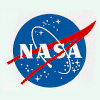|
Sunday:
December 29, 2002 | |
0001 GMT |
 |
Boeing to build third Wideband Gapfiller Satellite
Boeing has been awarded a U.S. Air Force contract option to build a third satellite in the Wideband Gapfiller Satellite program. Each satellite provides the United States and its allies with
increased space-based communications capability.
 FULL STORY FULL STORY
 |  |

|
 |
Space station Expedition 10 backup crew named
Astronauts Jeffrey Williams, Sunita Williams and Russian cosmonaut Konstantin Kozeev have been appointed to serve as the backup crew for the International Space Station Expedition 10.
 FULL STORY FULL STORY
 |  |

|
 |
|
Saturday:
December 28, 2002 | |
0258 GMT |
 |
Schools' radio-telescope project goes international
Most students at Hohenfels High School in Germany are from U.S. military families posted overseas. Sometimes America can seem far away. This month, the 11th and 12th graders in Joyce Dusenberry's astronomy class at the school made that distance shrink. From their classroom computer, they
pointed a large telescope in California to study a place that's really far away: Jupiter.
 FULL STORY FULL STORY
 |  |

|
 |
NASA awards contracts for remote sensing technology
NASA has awarded funding for nine new investigations for technology development of innovative Earth Science remote-sensing instruments, under the Instrument Incubator Program (IIP), to support the mission to understand and protect our home planet.
 FULL STORY FULL STORY
 |  |

|
 |
|
Friday:
December 27, 2002 | |
0012 GMT |
 |
Giant X-ray disk sheds light on elliptical galaxies
Astronomers have discovered the largest disk of hot, X-ray emitting gas ever observed in the universe: At 90,000 light years in diameter, it's about 100,000 times the size of any comparable object. The disk, spinning through a distant galaxy, is more than just an interstellar oddity, the researchers say. The object could offer new information about the way certain galaxies form and evolve.
 FULL STORY FULL STORY
 |  |

|
 |
|
Thursday:
December 26, 2002 | |
0100 GMT |
 |
Integral's first look at the gamma-ray Universe
The high-energy Universe is a violent place of exploding stars and their collapsed remnants such as the ultra-compressed neutron stars and, at the most extreme, all-consuming black holes. These celestial objects create X-rays and gamma rays that are many times more powerful than the optical radiation we can see with our eyes and optical telescopes.
 FULL STORY FULL STORY
 |  |

|
 |
Artemis nearly there
The end of the final stage of the Artemis recovery is now in sight. Only 700 km orbital height and about 45 days now remain before Artemis will reach geostationary orbit. Artemis is now expected to be in its working position by the end of January 2003.
 FULL STORY FULL STORY
 |  |

|
 |
Proton lofts navigation trio
A Russian Proton rocket and its Block DM upper stage launched three military navigation satellites for the GLONASS constellation Wednesday. Nearly a month ago, a similar upper stage malfunctioned and left a commercial communications satellite in the wrong orbit. Russian officials were able to exonerate the hardware used in Wednesday's mission.
 |  |

|
 |
|
Wednesday:
December 25, 2002 | |
0400 GMT |
 |
Which ringed planet?
Don't worry - you are not the only one who thought this was a nice amateur photo of planet Saturn, Lord of the Rings in our Solar System! But then the relative brightness and positions of the moons may appear somewhat unfamiliar...and the ring system does look unusually bright when compared to the planetary disk? Well, it is not Saturn.
 FULL STORY FULL STORY
 |  |

|
 |
|
Tuesday:
December 24, 2002 | |
1500 GMT |
 |
First elusive 'dark' gamma-ray burst caught
For the first time, scientists -- racing the clock -- have snapped a photo of an unusual type of gamma-ray-burst event one minute after the explosion. They captured a particularly fast-fading type of "dark" burst, which comprises about half of all gamma-ray bursts.
 FULL STORY FULL STORY
 |  |

|
 |
Russia launches secret military payload
Delayed from October after a similar Soyuz rocket exploded at Russia's Plesetsk Cosmodrome, a Molniya M was successfully launched from there Tuesday carrying a classified military cargo dubbed Cosmos 2393. Liftoff reportedly occurred at 1220 GMT (7:20 a.m. EST).
 WORLDWIDE LAUNCH SCHEDULE WORLDWIDE LAUNCH SCHEDULE
 |  |

|
 |
|
Monday:
December 23, 2002 | |
0400 GMT |
 |
NASA tests future flight vehicle concepts
A hybrid rocket carrying futuristic space vehicle concepts completed its first flight last week from Wallops Island. The rocket, built by Lockheed Martin, was used to launch a NASA designed payload containing three test articles.
 FULL STORY FULL STORY
 |  |

|
 |


 This exceptional chronicle of the historic Apollo 11 lunar landing mission features new digital transfers of film and television coverage unmatched by any other.
This exceptional chronicle of the historic Apollo 11 lunar landing mission features new digital transfers of film and television coverage unmatched by any other.